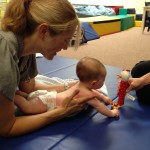Move Play Grow is three years old and I now have a “preschooler” on my hands. I’ve learned so much from the over 450 babies and families I’ve taught in that time and I want to take this moment to thank you all, to share some great photos of my happy babies in tummy time, and of course to offer some tips to help the next generation of happy tummy timers! See you in class!

Think about tummy time differently. Tummy time is not “exercise time.” It’s merely an opportunity for baby to get to know his front side. In that regard, no need to try to encourage him to pick up his head, unless of course he is inclined to do so. Take your baby’s lead, respect where he is, and join him in his world rather than always trying to get him to do something we expect of him. Resting his head on the ground is perfect.
 Reclaim lost tummy hours. Before the AAP introduced “Back to Sleep” in 1994, babies experienced up to 20 hours of tummy time per day, including wake and sleep hours. Now babies are lucky to get 30 minutes cumulative per day. Let’s reclaim some of this time while baby is awake to support baby’s gross motor, fine motor, sensory, and vision development. If you start early (ideally day of birth), your baby will thrive in this position.
Reclaim lost tummy hours. Before the AAP introduced “Back to Sleep” in 1994, babies experienced up to 20 hours of tummy time per day, including wake and sleep hours. Now babies are lucky to get 30 minutes cumulative per day. Let’s reclaim some of this time while baby is awake to support baby’s gross motor, fine motor, sensory, and vision development. If you start early (ideally day of birth), your baby will thrive in this position.
 Consistency is key. When putting baby down, choose tummy first, even if it only lasts a few minutes. Minimize use of infant seats, car seats, swings, standers, etc because these “containers” limit baby’s self-discovery. The floor provides countless opportunities for exploring, learning, making mistakes, and developing. Try for 90 minutes of tummy time (awake) by age three months.
Consistency is key. When putting baby down, choose tummy first, even if it only lasts a few minutes. Minimize use of infant seats, car seats, swings, standers, etc because these “containers” limit baby’s self-discovery. The floor provides countless opportunities for exploring, learning, making mistakes, and developing. Try for 90 minutes of tummy time (awake) by age three months.
*Note: Baby usually goes through a period between 2.5 and 3.5 months where tummy time is not as fun. Learn what you can do to get through this period. *
 When placed down, firm surfaces are safest. Place baby on a firm surface for tummy time, not a bed or couch. You want your baby to be successful pushing body away from the ground rather than sinking into it and you want to minimize creating air pockets that can cause breathing difficulty. Lie down on floor with your baby, so they can see, hear and interact with you best.
When placed down, firm surfaces are safest. Place baby on a firm surface for tummy time, not a bed or couch. You want your baby to be successful pushing body away from the ground rather than sinking into it and you want to minimize creating air pockets that can cause breathing difficulty. Lie down on floor with your baby, so they can see, hear and interact with you best.
 Make modifications before “saving” baby. When baby becomes a little fussy on her tummy, try making some modifications first to make tummy time easier, more fun or interesting before swooping her up. Change your play, facilitate weight shifts back towards her pelvis, bring her arms forward (depending on age), or help her roll to her side for a break. Learn the handling techniques for these subtle cues in class.
Make modifications before “saving” baby. When baby becomes a little fussy on her tummy, try making some modifications first to make tummy time easier, more fun or interesting before swooping her up. Change your play, facilitate weight shifts back towards her pelvis, bring her arms forward (depending on age), or help her roll to her side for a break. Learn the handling techniques for these subtle cues in class.
 Arms in front. A baby’s tummy time abilities and enjoyment improve as his weight shifts backwards towards the pelvis and as his arms migrate forward. By three months, a baby’s elbows should regularly be at or in front of the shoulders. When assisting a baby more than 2.5 months old, facilitate the arms forward so elbows are in line with shoulders. With younger babies, allow their elbows to remain behind their shoulders.
Arms in front. A baby’s tummy time abilities and enjoyment improve as his weight shifts backwards towards the pelvis and as his arms migrate forward. By three months, a baby’s elbows should regularly be at or in front of the shoulders. When assisting a baby more than 2.5 months old, facilitate the arms forward so elbows are in line with shoulders. With younger babies, allow their elbows to remain behind their shoulders.
 Vertical is easier, horizontal harder when trying to lift head. When a baby is lying on his tummy flat on floor, it takes a lot of effort to lift his head against gravity. This position is the end goal, but if your little one needs some coaxing to learn to love tummy time, you can make it easier by placing him on an incline across your lap with one thigh raised up. This is better than a prop because you can respond immediately to needs/changes.
Vertical is easier, horizontal harder when trying to lift head. When a baby is lying on his tummy flat on floor, it takes a lot of effort to lift his head against gravity. This position is the end goal, but if your little one needs some coaxing to learn to love tummy time, you can make it easier by placing him on an incline across your lap with one thigh raised up. This is better than a prop because you can respond immediately to needs/changes.
 It’s not just about the floor. Tummy time does not always have to happen on the floor. Chest to chest time with parents and caregivers is a fun way to accomplish tummy time while also bonding with your baby! Baby lying across your lap or being carried in a foot ball hold also counts as tummy time. Learn how to do these moves most effectively in class.
It’s not just about the floor. Tummy time does not always have to happen on the floor. Chest to chest time with parents and caregivers is a fun way to accomplish tummy time while also bonding with your baby! Baby lying across your lap or being carried in a foot ball hold also counts as tummy time. Learn how to do these moves most effectively in class.
Most importantly, be with your baby and have fun with lots of smiles and giggles!
